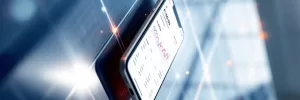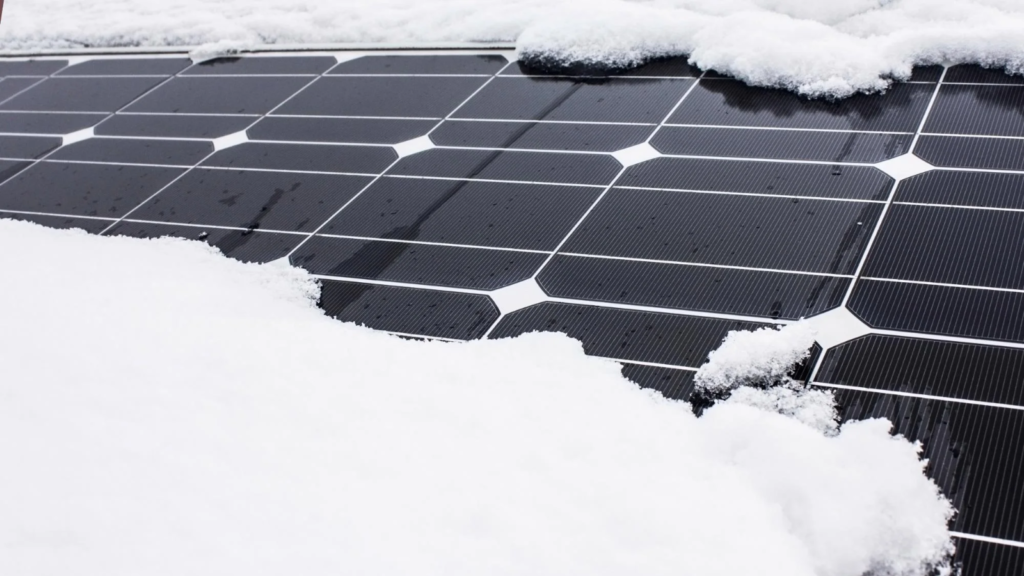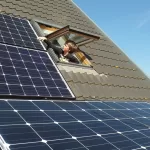As winter sets in and snow begins to cover the landscape, many homeowners with newly installed solar panels wonder if their system will still produce electricity. A common question arises: do solar panels work when covered with snow?
As a general rule, when solar panels are fully buried under a heavy snowfall, they can’t generate power because the snow blocks the sunlight. However, if the panels are only lightly dusted with snow or covered with frost, they can still receive enough sunlight to produce electricity, though at a slightly reduced rate. In most cases, snow’s impact on solar panel performance is minimal.
Winter days tend to generate less energy than summer days, but this is accounted for in the design of solar panel systems. Professional installers plan solar arrays to ensure they can still produce enough energy even in less favorable weather conditions. Additionally, snow doesn’t stay on solar panels for long because their angle and heat absorption properties help to melt it off. In fact, snowfall can act as a natural cleaning service, removing dust and debris, which can actually improve the efficiency of the panels.
So, homeowners needn’t worry about snow affecting the performance of their solar panels—solar systems are designed to handle such conditions effectively.

How to Prevent and Reduce Snow Cover on Solar Panels?
To prevent and reduce the impact of snow on solar panel performance, several effective strategies and measures should be taken. Below are some of the most effective ways to avoid snow cover and maintain optimal solar panel efficiency.
1. Adjust the Tilt Angle of Solar Panels
The angle at which solar panels are installed is a critical factor in reducing snow accumulation. Research has shown that solar panels installed at steeper angles are more likely to shed snow than panels installed flat. Typically, the tilt angle of solar panels should be set between 30° and 60° depending on local climate conditions and the amount of snowfall. For colder regions, such as in Nordic countries, a tilt angle between 40° and 60° is ideal, as this angle helps snow slide off the panels naturally. Studies have found that for every 10-degree increase in tilt angle, the likelihood of snow sliding off the panels increases by about 15%.
2. Heating Systems for Solar Panels
Installing a heating system is an effective solution, especially in areas where heavy snowfalls or extremely low temperatures are common. Heating systems help prevent snow from accumulating on solar panels by melting it or preventing initial accumulation. Common heating solutions for solar panels include electrical heating films, self-regulating heating cables, and infrared heating devices. These systems typically use heating elements installed on the back or surface of the solar panels to raise their temperature. The power requirement for these systems is typically around 100 watts per square meter, and the operation time and temperature should be adjusted based on local weather conditions to ensure that snow does not build up on the panels.
3. Anti-Snow Coatings
Another preventive measure is the use of anti-snow coatings. These coatings create a smooth, non-stick surface on the panels, reducing the adhesion of snow and ice. Anti-snow coatings are often made from silicone-based or fluoropolymer materials, which offer water-repellent and anti-contaminant properties. These coatings can help reduce the accumulation of snow by about 20% to 50%. The effectiveness of these coatings depends on the quality of the material and local environmental conditions, so it is essential to choose high-quality coatings that will last under extreme weather.
4. Regular Snow Removal
Another important way to ensure efficient energy production is by regularly removing accumulated snow from solar panels. Periodic checks and removal of snow help prevent large snow piles from blocking sunlight. When cleaning snow off solar panels, use special snow removal tools such as plastic scrapers or soft-bristled brushes to avoid damaging the surface of the panels. It is recommended to check the snow accumulation on the panels at least once a month during winter, especially in areas with significant snowfalls. If the snowfall exceeds 5 to 10 cm, it is advisable to remove the snow to maintain high efficiency.
5. Choose Solar Panels Designed for Snowy Regions
Selecting solar panels specifically designed for snowy regions can be an effective way to prevent snow accumulation. These specialized high-snow-load solar panels are built with enhanced structural integrity to withstand heavier snow loads without damaging the panels. In addition, some solar panels come with anti-icing designs or anti-reflective coatings, which help reduce snow build-up. Choosing such panels is especially beneficial in regions that experience frequent snowstorms and heavy snowfall.
6. Consider Snow Load Factors
When installing a solar system in cold regions, it is essential to consider snow load factors—the maximum weight of snow that the system can bear per unit area. In areas with heavy snowfall, such as Northern Europe or Canada, solar systems should be designed to support higher snow loads. For example, in Finland, the snow load standards for solar systems require them to bear up to 300 kg/m² of snow weight. Before installation, it is important to work with local meteorological and building experts to ensure that the solar system is properly designed to withstand the snow load in that particular area.
7. Choose an Optimal Installation Location
The installation location of solar panels can significantly affect the amount of snow accumulation. Avoid placing solar panels in areas that are frequently shaded, such as areas near tall buildings, trees, or other obstructions. Shaded panels tend to be colder and more likely to retain snow on their surfaces, while panels that receive ample sunlight are more likely to shed snow. When choosing an installation location, consider the changing angle of the sun throughout the day and year, and select a location that maximizes sun exposure.

What Types of Solar Panels Perform Better in Snow?
In snowy conditions, it’s important to choose solar panels designed to withstand heavy snow and enhance energy production even when covered with snow. Here are recommendations for solar panels in such environments:
- High Power Output Panels:Panels with higher wattage, like 400W+ panels, are ideal. They maintain efficiency in low-light conditions such as winter months.
- Full Black Panels:Panels with dark surfaces, like 375W full black panels, absorb more heat, helping snow melt faster.
- Dual-Glass Panels:Double-glass solar panels are more robust and can handle the weight of snow without cracking. They also help with snow shedding.
- High Efficiency PERC or HJT Panels: Panels with PERC (Passivated Emitter Rear Cell) or HJT (Heterojunction Technology) provide better performance in cold temperatures and low light.
- Solar Panels with Anti-Snow Coating:Look for panels with anti-reflective and anti-wear coatings to prevent snow and dirt buildup.
Conclusion
Knowing how to prevent snow and ice buildup on your solar panels is key to maintaining their efficiency and maximizing energy production in winter. Effective methods like adjusting tilt angles, using heating systems, and applying anti-snow coatings can help keep your panels clean and functioning well in snowy conditions.
It’s important to always prioritize safety, especially when removing snow or installing protective systems. Consulting professionals ensures that you choose the best solutions for your setup and that your solar system remains durable and efficient. By taking these proactive steps, you can keep enjoying the benefits of clean, renewable solar energy all winter long.
Since 2008, Maysun Solar has been committed to producing high-quality photovoltaic modules designed to perform efficiently in all climates, including snowy conditions. Our advanced solar technologies, such as IBC, HJT, and TOPCon panels, are engineered to maximize energy output and prevent snow buildup, ensuring reliable performance even during winter. With offices and warehouses established worldwide, Maysun Solar has built strong partnerships with leading installers, offering tailored solutions for both residential and commercial needs. Whether you’re looking for rooftop systems or balcony solar stations, our products guarantee superior efficiency and long-term durability. For the latest quotes or any inquiries related to solar energy, reach out to us today. We’re dedicated to providing you with top-tier solar solutions that ensure clean, reliable energy throughout the year.
You may also like:

Empowering Factories with Solar Energy A Strategic Tool for Controlling Production Electricity Costs
Commercial and industrial solar is becoming a key solution for factories to reduce electricity costs and hedge against price fluctuations. This article systematically analyzes its deployment models, cost advantages, and sustainable value pathways.

How Businesses Can Offset Carbon Taxes with Solar Power
This article analyzes the latest carbon tax policies and photovoltaic deduction strategies, helping European businesses legally reduce taxes, increase profits through solar investment, and achieve a win-win situation for both economy and environment.

Forecast and Response: Seizing the Next Decade’s Growth Dividend in Europe’s Commercial and Industrial Photovoltaics Market
Maysun Solar analyzes the growth trends of commercial and industrial photovoltaics in Europe over the next ten years, from policies and ESG to technological innovation, helping companies seize the initiative in the energy transition.

How to Calculate Solar System ROI and Optimize Long-Term Returns?
Solar power is becoming a key solution for businesses to reduce costs and improve efficiency. Accurately calculating ROI and optimizing long-term returns are essential to maximizing investment value.

Will Agrivoltaics Affect Crop Growth?
Agrivoltaics combines solar energy and agriculture to reduce up to 700 tons of CO₂ per MW, improve water use, and boost crop growth for sustainable farming.

6.5 Billion Loss Hits Photovoltaics: Reshaping or Elimination?
In 2025, the photovoltaic market may see a turnaround as some companies take early action. A €6.5 billion loss is driving businesses to explore new growth areas like energy storage and hydrogen. Which giants will break through? Industry transformation is accelerating!



